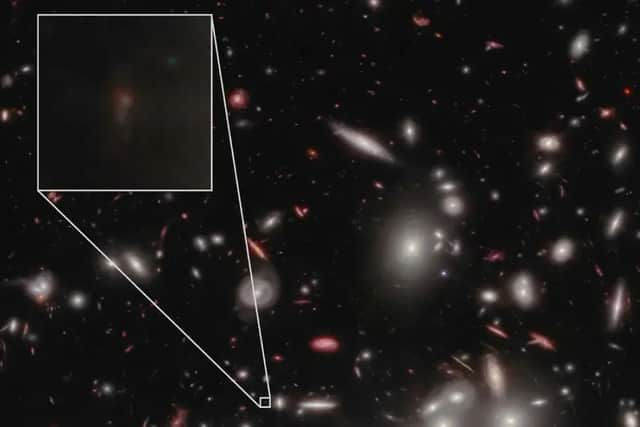James Webb Space telescope: astrophysicists discover faintest galaxy - is this the furthest ever detected?
This article contains affiliate links. We may earn a small commission on items purchased through this article, but that does not affect our editorial judgement.
and live on Freeview channel 276
One of the most distant galaxies ever observed has been found by the James Webb Telescope (JWST) and identified by an international team headed by UCLA astrophysicists. The galaxy is so remote, its light is almost invisible, revealing its ancient age.
The researchers who found this dim, distant galaxy published their findings in the journal Nature, and this galaxy is one of the most distant identified to this date. It is typical of the types of galaxies that burned through the fog of hydrogen atoms left over from the Big Bang.
Advertisement
Hide AdAdvertisement
Hide AdSo when was this galaxy formed? How far is it, what has it been named, and what can it tell us about the universe? Here is what you need to know.
When was this galaxy formed?
This ancient galaxy, called JD1, has been observed as from 13.3 billion years ago, when the universe was around 4% of its current age. Meaning it was born just a few million years after the Big Bang when the cosmos was covered in a pitch-black fog.
After the Big Bang, the universe expanded and cooled to the point that hydrogen atoms could form. But in the absence of light from the first stars and galaxies, the universe entered a time known as the cosmic dark ages. When stars and galaxies began to form and several hundred million years later, they began to burn away the hydrogen fog left by the Big Bang, so the universe became transparent.
“Most of the galaxies found with JWST so far are bright galaxies that are rare and not thought to be particularly representative of the young galaxies that populated the early universe,” said Guido Roberts-Borsani, a UCLA postdoctoral researcher and the study’s first author. “As such, while important, they are not thought to be the main agents that burned through all of that hydrogen fog.
Advertisement
Hide AdAdvertisement
Hide Ad“Ultra-faint galaxies such as JD1, on the other hand, are far more numerous, which is why we believe they are more representative of the galaxies that conducted the reionization process, allowing ultraviolet light to travel unimpeded through space and time.”


JADES-GS-z13-0 is the most distant galaxy confirmed spectroscopically, with its light coming to Earth from 320 million years after the Big Bang, according to The Big Think who regularly interviews scientific experts. This galaxy was found by the JWST on 29 September 2022, and has a light-travel distance of 13.6 billion years.
However, a paper in April 2023 suggests that JADES-GS-z13-0 is actually a dark star ( a star which existed early in the universe before conventional stars could form).
How was JD1 found?
The researchers used the JWST’s near-infrared spectrograph instrument, NIRSpec to create an infrared light spectrum of the galaxy. In return, this allows them to determine the galaxy’s precise age and distance from Earth.
Another one of the JWST near-infrared instruments, NIRCam, helped the team study the galaxy's structure in detail and resolution, revealing three main elongated clumps of dust and gas that form stars. With this information, the team could determine the origin and shale of JD1’s light, and identify a galaxy that is only a small portion of the size of older galaxies, such as the Milky Way which is 13.6 billion years old.
JD1 sits behind a large cluster of nearby galaxies, called Abell 2744, and its combined gravitational strength bends and accentuates the light from JD1 - which makes it appear larger and 13 times brighter than it usually would. This effect is known as gravitational lensing and without this, JD1 might have been missed.
What can JD1 tell us about the universe?
Advertisement
Hide AdAdvertisement
Hide AdWith the revelation of this ancient faint galaxy, astrophysicists should be able to determine how the cosmic dark ages ended. The aim would be to use this technique to find more of these first galaxies, and how they reionized the hydrogen fog, in a period known as the Epoch of Reionization.
“Before the Webb telescope switched on, just a year ago, we could not even dream of confirming such a faint galaxy,” said Tommaso Treu, a UCLA physics and astronomy professor, and the study’s second author. “The combination of JWST and the magnifying power of gravitational lensing is a revolution. We are rewriting the book on how galaxies formed and evolved in the immediate aftermath of the Big Bang."
Comment Guidelines
National World encourages reader discussion on our stories. User feedback, insights and back-and-forth exchanges add a rich layer of context to reporting. Please review our Community Guidelines before commenting.
